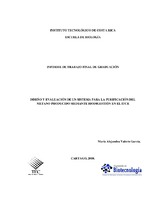Mostrar el registro sencillo del ítem
Diseño y evaluación de un sistema para la purificación de metano producido mediante biogestión en el ITCR
| dc.contributor.advisor | Rivas-Solano, Olga | es |
| dc.contributor.author | Valerio-García, María Alejandra | |
| dc.date.accessioned | 2015-10-14T17:29:44Z | |
| dc.date.available | 2015-10-14T17:29:44Z | |
| dc.date.issued | 2010 | |
| dc.identifier.uri | https://hdl.handle.net/2238/6312 | |
| dc.description | Proyecto Final de Graduación (Bachillerato en Ingeniería en Biotecnología). Instituto Tecnológico de Costa Rica. Escuela de Biología, 2010. | es |
| dc.description.abstract | The use of biogas as an alternative energy source is being limited by the need to remove certain gases which reduce the combustion potential of methane present in biogas. Among these gases, H2S can lead to corrosion problems which restricts biogas from being compressed and stored. On the other hand, CO2 is not a combustible gas, therefore it reduces the calorific value of biogas. The aim of this reasearch project was to build and put into function a small-scale purification system for biogas at the ITCR, which was simple and would generate high quality CH4. The system established consisted of a biological desulfurisation process to reduce the concentration of H2S, and a scrubber for the chemical absorption of CO2 using NaOH. In order to evaluate the purification system´s efficiency, the composition of the biogas treated was analyzed before and after the purification processes took place. For the biological desulfuration of biogas, a tank was designed to hold a liquid phase consisting of a culture of the aerobic bacteria A.thiooxidans y S. novella capable of sulphur oxidation, so that in presence of air, H2S would be consumed by the bacteria when biogas passed through the tank. Among the design parameters for the tank, a retention time of 1 hour was established and also the air introduced in the tank did not exceed 5% of the volume of biogas in it. The tank design and the bacteria allowed a 56% removal rate of H2S from biogas. Meanwhile the absorption scrubber was adapted to one of the experimental biodigesters at the ITCR, in order to remove CO2 from the biogas produced. The scrubber constructed was packed and allowed a counter-current absorption process, using NaOH 2.5M as the absorbent. Certain problems with the design and functioning of the column, the introduction of uncompressed biogas with a small flow rate and a very concentrated absorbent, were possible reasons why this process was not an efficient method for the purification of biogas, since the expected increase in the percentage of CH4 in the biogas did not occur. | es |
| dc.description.sponsorship | Instituto Tecnológico de Costa Rica. Escuela de Biología. | es |
| dc.language.iso | es | es |
| dc.publisher | Instituto Tecnológico de Costa Rica | es |
| dc.rights | acceso abierto | es |
| dc.subject | Factores | es |
| dc.subject | Biogás | es |
| dc.subject | Procesos | es |
| dc.subject | Motores de combustión interna | es |
| dc.subject | Contaminantes | es |
| dc.subject | Eficiencia | es |
| dc.title | Diseño y evaluación de un sistema para la purificación de metano producido mediante biogestión en el ITCR | es |
| dc.type | proyecto fin de carrera | es |
Ficheros en el ítem
Este ítem aparece en la(s) siguiente(s) colección(ones)
-
Diseño industrial [12]


